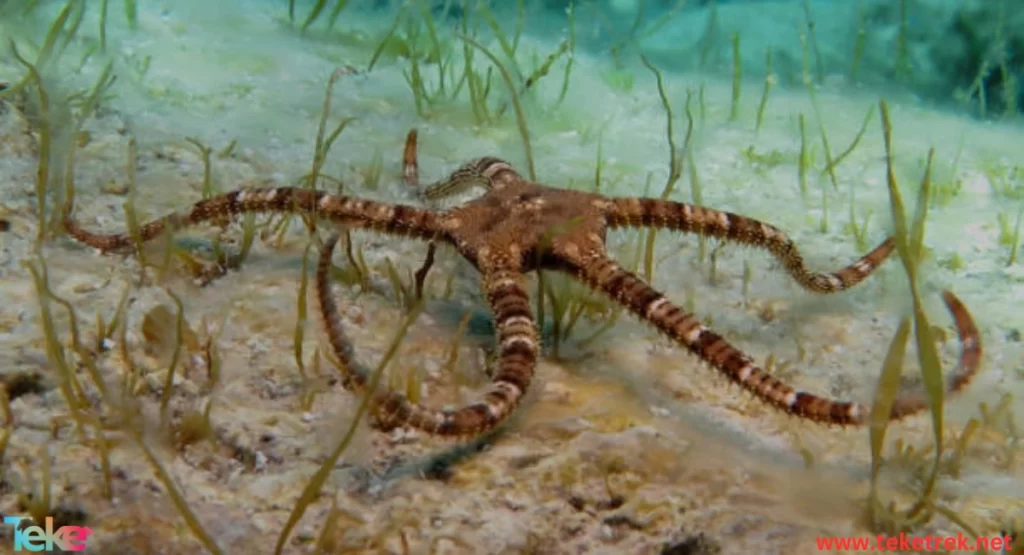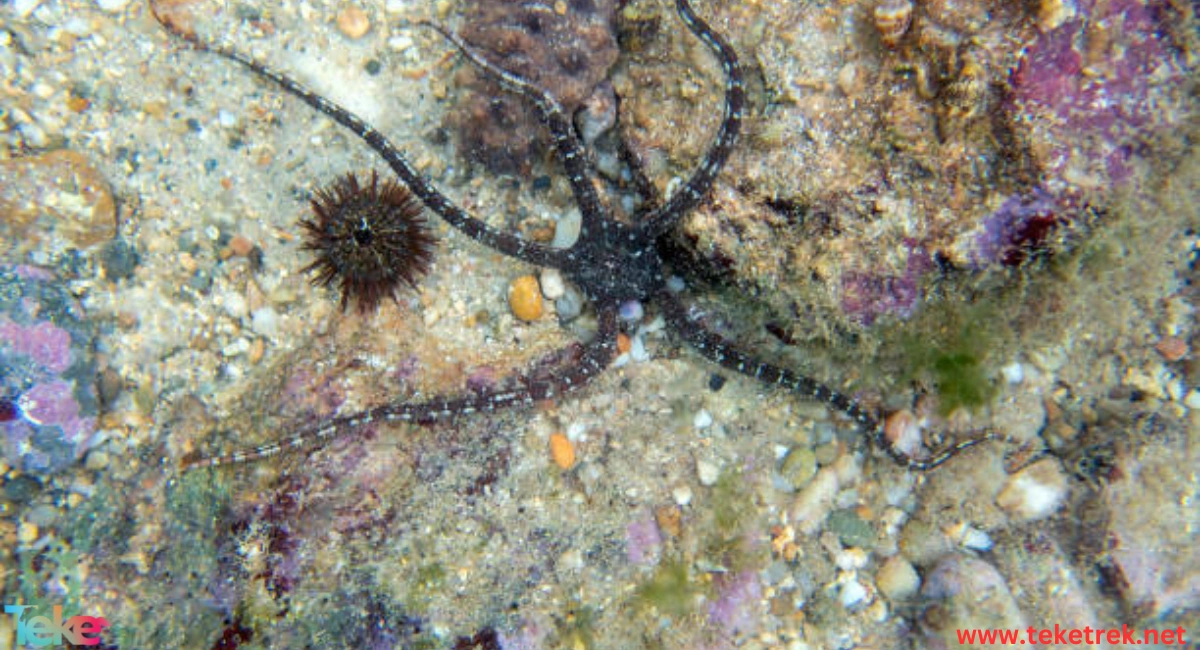It is a marine invertebrate belonging to the phylum Echinodermata, class Ophiuroidea, order Phanerozoa, subclass Asteroidea, and family Ophiuridae.
Let’s learn more about it from teketrek.
The Brittle Star specification
- The Color: The common Brittle Star has subtle colors that help it avoid predation.
It is usually red, white, or brown, with some also being spotted.
- The arms: The Brittle Star has numerous arms arranged in two rows on each side of its body. These arms contain delicate tube feet used for attachment to surfaces and movement.
- The length, spines: The central body disc diameter of the Brittle Star ranges from 2 to 20 mm, with its five long and slender arms typically being five times the body diameter in length. They are divided by tube feet and have seven serrated spines per segment. The central body is also covered with spines.

What is the behavior of the Brittle Star
The Brittle Star forms dense clusters, ranging from 340 to over 2000 individuals per square meter.
The Brittle Star exhibits secretive behavior, hiding under rocks and crevices during the day.
Brittle Stars form their groups based on interactions with other Brittle Stars, not necessarily due to environmental cues.
There is some evidence that Brittle Stars communicate using pheromones.
Despite not having a brain, the Brittle Star has an independent nervous system.
The name Brittle Star comes from its resemblance to a star, with many species reaching up to 2000 types.
The difference lies in the number of arms, which can be 10 arms for some and 20 arms for others.
The Brittle Star somewhat resembles a sea lily in shape, but it separates at an early stage of life, allowing it to live freely and swim short distances.
Where does the Brittle Star live
The Brittle Star lives in extremely large groups far away from the shore, often found under shells or rocks, but can also be found in rocky reefs and soft bottom layers.
Brittle Stars are commonly found off the coasts of British Isles, although they are not recorded from the east coast of Scotland, as well as along all other coasts bordering the North Sea and throughout the eastern Atlantic Ocean, as far south as Cape Verde.
Brittle Stars have also been found around the Azores Islands.
What is the diet of the Brittle Star
The Brittle Star feeds at night, raising its arms through cracks in rocks to pass particles to its mouth, where it uses a pair of tube feet in its mouth and both the vertical row of teeth and a set of toothed plates to consume its food.
The diet of the Brittle Star largely consists of detritus, diatoms, plant plankton, and sometimes scavenging dead material.
Reproductive stages of the Brittle Star
The common brittle star reproduces by releasing sperm and eggs into the water, with males releasing sperm and females releasing eggs..
The fertilized egg grows in the water column.
While reproduction of the common Brittle Star is reported year-round in some areas and until late October in others, reproductive glands are usually most developed from May to July.
What is the life cycle of the Brittle Star
The Brittle Star has three main life stages: the larva, juvenile Brittle Star, and adult Brittle Star.
The development from larva to adulthood takes 20 to 30 days, depending on nutrient availability.
Full maturation may take 6 to 10 months.

FAQs about Brittle Star
- Why doesn’t the Brittle Star live in freshwater?
Due to its body structure differing from other marine organisms, the Brittle Star cannot survive in freshwater.
To stay alive, it remains in the seas, and if placed in freshwater, it will die.
- What are the benefits of the Brittle Star?
The outer body of the Brittle Star contains a non-sticky substance that treats human infections such as arthritis and some fevers.
It is also used as an analgesic to alleviate pain, leading to medical research ideas using non-sticky substances to prevent human tissue damage.
- Is brittle star asexual?
Some sea stars and brittle stars can reproduce asexually by duplicating themselves.We now know that A, muricatum is one of those species.
- Do brittle stars still exist?
Over 2,000 species of brittle stars live today. More than 1,200 species of these organisms are found in deep waters, at depths greater than 200 meters..
- What is a fact about brittle stars?
Each brittle star has a distinct central disk made of calcium carbonate, which houses all its internal organs, and five slender, flexible arms that twist and coil to aid in movement across the seafloor.
- Can you touch a brittle starfish?
Brittle stars can shed parts of their arms if disturbed or threatened, so it is advisable to observe them without touching.
- Do brittle stars have a heart?
Brittle stars, like all echinoderms, lack a head, eyes, brain, and heart.
- Are brittle stars venomous?
No, brittle stars are not venomous.
In conclusion, it is important to highlight the significance of this animal in maintaining ecological balance.
References:





